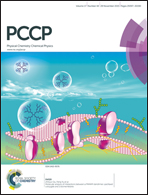Multicomponent kinetic analysis and theoretical studies on the phenolic intermediates in the oxidation of eugenol and isoeugenol catalyzed by laccase†
Abstract
Laccase catalyzes the oxidation of natural phenols and thereby is believed to initialize reactions in lignification and delignification. Numerous phenolic mediators have also been applied in laccase-mediator systems. However, reaction details after the primary O–H rupture of phenols remain obscure. In this work two types of isomeric phenols, EUG (eugenol) and ISO (trans-/cis-isoeugenol), were used as chemical probes to explore the enzymatic reaction pathways, with the combined methods of time-resolved UV-Vis absorption spectra, MCR-ALS, HPLC-MS, and quantum mechanical (QM) calculations. It has been found that the EUG-consuming rate is linear to its concentration, while the ISO not. Besides, an o-methoxy quinone methide intermediate, (E/Z)-4-allylidene-2-methoxycyclohexa-2,5-dienone, was evidenced in the case of EUG with the UV-Vis measurement, mass spectra and TD-DFT calculations; in contrast, an ISO-generating phenoxyl radical, a (E/Z)-2-methoxy-4-(prop-1-en-1-yl) phenoxyl radical, was identified in the case of ISO. Furthermore, QM calculations indicated that the EUG-generating phenoxyl radical (an O-centered radical) can easily transform into an allylic radical (a C-centered radical) by hydrogen atom transfer (HAT) with a calculated activation enthalpy of 5.3 kcal mol−1 and then be fast oxidized to the observed eugenol quinone methide, rather than an O-radical alkene addition with barriers above 12.8 kcal mol−1. In contrast, the ISO-generating phenoxyl radical directly undergoes a radical coupling (RC) process, with a barrier of 4.8 kcal mol−1, while the HAT isomerization between O- and C-centered radicals has a higher reaction barrier of 8.0 kcal mol−1. The electronic conjugation of the benzyl-type radical and the aromatic allylic radical leads to differentiation of the two pathways. These results imply that competitive reaction pathways exist for the nascent reactive intermediates generated in the laccase-catalyzed oxidation of natural phenols, which is important for understanding the lignin polymerization and may shed some light on the development of efficient laccase-mediator systems.


 Please wait while we load your content...
Please wait while we load your content...